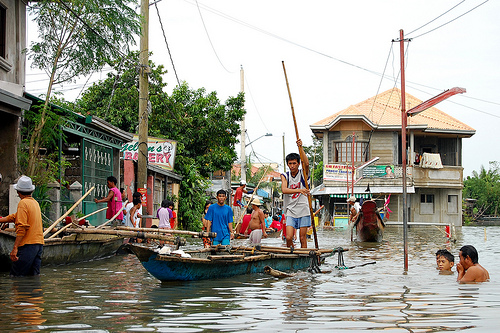Lessons in adaptation planning and management from the flooding in Metro Luzon
In August this year, Metro Manila and outlying provinces (Bulacan, Pampanga, and Pangasinan to the North; Laguna to the South - the conurbation referred to as Metro Luzon) were caught red-handed by the flooding caused by intensified monsoon rains this time. Two million were affected. To date, 144,070 people (31,886 families) in the Metro and Laguna are still in evacuation centers.
Flooding is not new to the Metro or the country given that it is visited half of the year by typhoons and monsoon rains. The last typhoon-related flooding disaster which affected the Metro was not too long ago, from Typhoon Ketsana (Ondoy) in 2009. Yet, public management of the recent event showed that it was as if flooding was a new occurrence.
 (Photo courtesy of IRRI Images under a Creative Commons license)
(Photo courtesy of IRRI Images under a Creative Commons license)
In the Philippines, climate change adaptation is a law (Republic Act 9729), and the legal mandate is supported by a 12-year (2010-2022) national strategy. But, it seems the implications of these instruments have not yet seeped into the consciousness of most citizens and even public leaders. As if throwing wide open closed doors, the flooding which locals refer to as "habagat" presents yet again important lessons in urban and regional planning and management, some of which I've outlined below:
Urban Management Structure for the Metropolitan. Following the flooding, media cited the lack of coordination between and among Local Government Units and concerned national agencies as a significant reason for the Metro's lack of preparedness. At the height of the flooding, rescue and operations was led by the National Disaster Risk Reduction Management Council (NDRRMC), essentially a policy-making body created under the national Disaster Risk Reduction and Management Law (Republic Act 10021). The rescuers were recruited by the Council from its parent organization, the Office of Civil Defense which is under the Philippine Military. Further, City Halls and Local Government Units in the barangays (villages) of the affected areas conducted their own operations, within their jurisdictions.
Who is the manager of Metropolitan Manila?
Governance of the Metropolitan, according to Republic Act 7924, is with the Metro Manila Development Authority (MMDA). Strategic planning for Metro Manila, which includes ensuring that individual Local Government Units which comprise the Metropolitan integrate DRR and CCA into their plans and systems, rests with the MMDA. However, the MMDA has been more visible in traffic enforcement in the Metro hence is known by the public as such. Further, direct and uncoordinated intervention in the responsibilities of the MMDA such as the flooding by the President and/or government agencies headquartered in Manila (e.g. NDRRMC, DPWH) added to the public confusion. But more importantly this has divested the MMDA of its raison d' etre and credibility.
This calls for a review of the role of the MMDA in the governance of the metropolis, its functions, as well as its capacities given new and emerging challenges.
Housing and Building Standards Compliance and Monitoring.Flooding disasters in the country make visible the weakest link in urban management, that of quality of housing and buildings. On the issue of siting, slum communities in the Metro, total families estimated at 600,000, built along waterways are blamed for blocking the drainage path of floodwaters. Also, housing in slums is not compliant to structural standards. Without going into economic arguments these are but symptoms of the larger housing related issues of quality assurance, compliance monitoring, and legal aspects involving informal settlements.
Further, in view of the need to adapt to the changing environment and to be consistent with newer policies (e.g. National Urban Development and Housing), the National Building Code, enacted during the time of President Marcos, is due for review and updating.
Landscape Scale Planning.To protect your rivers, protect your mountains, so says a Chinese proverb.
The flooding didn't start and end in Metro Manila. Starting in June, Northern Luzon has been experiencing typhoons one after. This meant that water has been steadily making its way downstream. The volume of water moving downstream may have been slowed down, diverted, or facilitated by the level of anthropogenic activities and structures in each town and city (administrative boundary) it passed through. For instance, massive and rapid deforestation in the towns of Rizal to make way for settlements meant a great volume of runoff making its way into these towns and adjacent areas such as Metro Manila and Laguna. For Metro Manila, this meant an exacerbation of its problems on degraded water bodies (e.g Pasig River), poorly-designed drainage infrastructures, land subsidence, among others. The result is floodwaters that only take minutes to build up but weeks or months for it to subside.
Water drained out of the Metro into waterways such as the Pasig River that in turn flushed out the water into Laguna de Bay which due to siltation and degradation has increasingly lost its absorptive capacity.
What these natural interactions signify in terms of planning for adaptation is that current planning structure within administrative boundaries may not be the effective scale but rather the more effective scale is the broader context of the ecosystem or landscape.
Inter-Regional Cooperation and Planning.Planning at the landscape scale will entail lateral or interregional cooperation. The country's planning structure provides for hierarchical or vertical planning but none for formal lateral planning. Hierarchical or vertical planning is limited within administrative boundaries which as mentioned earlier runs against the logic of ecosystem processes. The lack of such a structure, in view of the emerging need for it, should be addressed. The agenda can be introduced and discussed in the League of Cities, League of Municipalities, and League of Provinces, in which Local Government Units are members.
Scaling Up Successful Pilot Initiatives. Many DRR and CCA initiatives funded by various organizations, local and international, government and non-government, through various financing schemes have been successfully implemented in the country's localities. These 'pilot' initiatives range from action research to setting up of information management systems to infrastructure and services support. The technologies however have remained in and largely benefitted the pilot areas. Dissemination and scaling up throughout the country of successful pilot initiatives can address the concern over spatial inequality.
Awareness Building and Education. Ignorance of DRR and CCA and related concepts, interactions between the environment and development, related laws and standards, and relevant technologies is a significant reason for why locals including Local Government Unit officials and their staff despite the mandates placed on them have been seemingly indifferent, passive, and inert in the face of perceptible and felt environmental changes.
The critical level of action which is the Barangay Local Government Unit tells a less-than-desired capability in DRR and CCA. LGU perspective despite the DRRM Law and the National CCA Strategy remains to be of emergency response. Hence the focus and priority given to skilling and equipping LGU personnel for this level. Few local leaders and decision-makers can articulate 'disaster risk reduction' in their own words. There is in effect a great divide between national level strategy and mandate and actual implementation at the local level.
Webb S. Fiser in Mastery of the Metropolis avers that "private action and public education are the essential preconditions of more sophistication in city hall" and that "a magnificent plan is possible only with an enlightened public. If the public conception of the good life is narrow and impoverished so will be the plan."
Citizen action operates on the same logic. Community mobilization is possible only when a critical mass of citizens has attained that level of awareness and knowledge which naturally propels individuals toward concern and action.
On the other hand, citizen action happens within organized systems, one of which is the Non-Government Organization. Yet, it cannot be said that NGOs, specifically local NGOs, despite their number and various representation of national issues, were significant contributors to significant change in the localities. In the end, significant change is mobilized by citizens, individuals or groups, who have deep awareness and knowledge of the issues, are convinced that they can make a difference, and act to make that difference a reality.
Research and Evaluation. National government, in the aftermath of the flooding, committed to a flood control measure for Manila de Bay, but is this really the best and most effective option? Credible environmentalists opined there are less costly but more effective solutions. One is rehabilitation of the ecosystem in the Metro and neighboring provinces of Rizal, Bulacan, and Laguna. The point is that options should be the result of research and evaluation, of evidence.
On the same note, urban managers and planners need to know the extent to which expected results were achieved and what factors in fact facilitated and constrained success of initiatives. The flooding in the Metro revealed the fact that lessons from the Typhooon Ketsana flooding had not been learned or integrated into the new set of LGU plans. And given that context is always changing, strategy making to be effective calls for continuous improvement and innovation.
___
*The author is a researcher and independent evaluator of development projects and programs with more than 10 years of front line work in I/NGO setting. Her focus areas include disaster risk reduction, climate change adaptation, urban management, and child rights-based programming.



